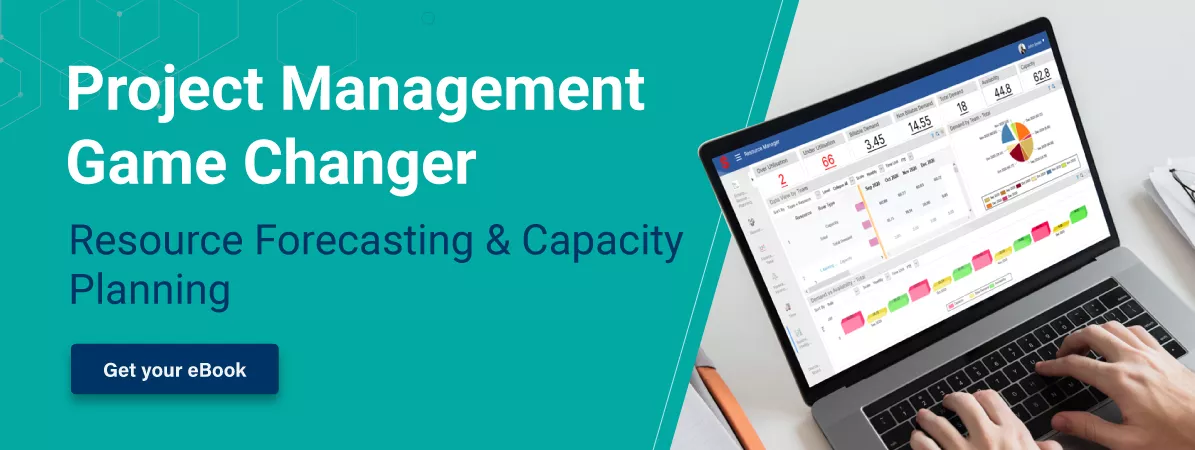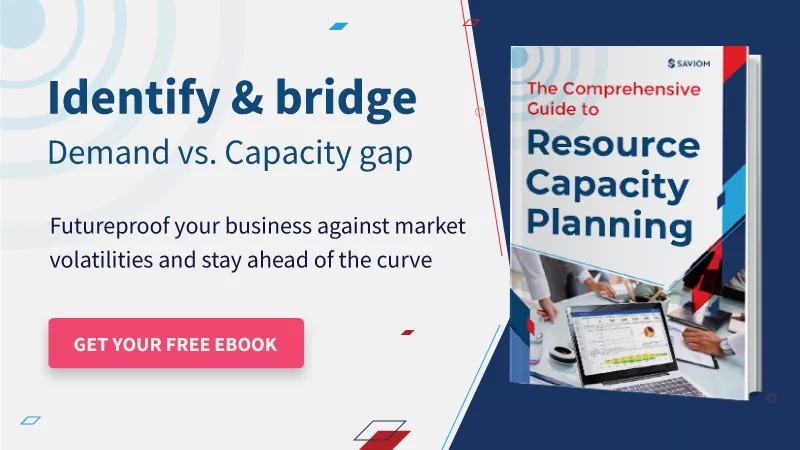The ever-growing competition and escalating market demands led organizations to expand their horizons and build up their portfolio. However, this means managing multiple projects simultaneously with precision. A single project encompasses a myriad of attributes starting from regulating the project finances & forming a full-proof project schedule to ensure competent workforce allocation.
Streamlining every factor to maintain the project’s health index is an arduous task. Now, imagine the efforts and diligence required to supervise these elements for several projects simultaneously.
Project portfolio management software is designed to address this complex situation. It facilitates project managers to consolidate data on a unified platform and track its progress in real-time.
However, one of the most imperative factors contributing to the project’s success is often overlooked, i.e., resource capacity planning. It is a comprehensive process that allows resource managers to fulfill the project demand well ahead of the curve to ensure timely delivery.

If followed meticulously, resource capacity planning can become a game-changer in the project portfolio management strategy. This blog will explain how,
How can PPM benefit from Resource Capacity Planning?
Before we delve into how resource capacity planning benefits the project portfolio management process, let’s first understand its definition,
What is resource forecasting & capacity planning?
Resource forecasting and capacity planning is a comprehensive process of predicting project resource demand, evaluating the gap between the demand and existing resource capacity, and finally taking the suitable resourcing measures to bridge the gap and fulfill the resource requirement well in advance. This approach promotes managers to be proactive and avoid potential bottlenecks in the future.
Benefits of resource capacity planning in PPM
As mentioned earlier, a portfolio consists of multiple projects, and the onus lies in project managers to deliver each project successfully. Therefore, it is imperative to ensure that they have the right talent to execute the project tasks with utmost efficiency. If not, it can have a catastrophic effect on the project’s performance.
Forecasting and capacity planning plays a crucial role here. It facilitates managers to foresee the resource demand for pipeline projects and request this personnel from resource managers ahead of time. It gives enough lead time to the resource managers to first analyze the skills gap and build a strategic plan to bridge it.
They can either do planned hiring or upskill or train the existing workforce. Moreover, a capacity planning solution also maintains the single version of truth. It accommodates the enterprise-wide information in a single repository. by accommodating the enterprise-wide information in a single repository.
Managers can make use of this and even recruit competent and cost-effective global resources across the matrix boundaries. By implementing these measures, they can reduce project costs significantly.
Furthermore, resource capacity planning enhances transparency at the workplace that eliminates conflicts between project managers. The enterprise-wide visibility keeps every manager informed about the ongoing projects and resource allocations which further negates the fire-fighting for the talent pool.
Overall, forecasting and capacity planning ensure individual projects’ timely execution, thereby making the whole portfolio a success.
In addition, it encourages advanced planning, future-proofs the workforce, and enhances the efficiency of a PPM strategy.

The following section will emphasize the various resource-centric challenges faced in PPM and how forecasting and capacity planning can help you combat those,
What are the resource-centric challenges in PPM?
According to PMI, 26% of projects fail due to resource dependency and 18% due to inaccurate resource forecasting techniques.
It can be attributed to the absence of a dedicated resource management process in place. Here is a run-down of the most prominent resource-centric challenges:
Lack of definite project selection criterion
Not every project that comes your way can add value to the portfolio or align with your long-term business goals. Therefore, project portfolio managers must form a systematic project selection criterion that will ascertain that no talent or resource is wasted on futile projects.
However, some organizations fail to form such a framework and allocate the workforce to projects that will not add to the bottom line in the long run. It also delays the critical and strategically aligned projects requiring the same skill set and, in worse cases, brings them to a halt.
Inadequate forward planning for pipeline projects
Proactive planning is at the crux of resource capacity planning. It is only possible when organizations have deployed modern resource management solutions that can provide data-driven foresight. However, many organizations still use primitive tools to form the project resource plan that fails to provide visibility into pipeline projects’ demand.
Without staying forewarned, project managers end up requesting resources at the eleventh hour that does not leave enough room for resource managers to form the right action plan. It can eventually lead to last-minute hiring, escalated project resource costs, inappropriate allocation, schedule overruns, and so on.
Insufficient information on resource utilization and availability
Before scheduling the resources to a specific project, it is critical to check their current schedules and availability in real-time. Otherwise, it can lead to double-booking, which will eventually cause overutilization and burnout. At the same time, managers should have an overview of the projects they are working on.
Sometimes, critical resources work on non-billable or non-priority projects that can lower their productivity and add to the firm’s financial expenditure as they do not bring any ROI. However, many organizations do not use the right software to get these real-time updates on resource metrics that lowers the resource and project health index at the same time.
Read More: What is Resource Utilization? A Complete Guide to Improve Business Efficiency
Absence of a centralized system to overview projects and resources
A project-led business is a conglomerate of multiple portfolios, and each of them comprises a myriad of projects. With the advent of globalization, companies have expanded their horizons and onboarded a vast expanse of the talent pool from across boundaries. To ensure the seamless functioning of a system, it is vital to stay connected and updated on the know-how of each office.
Unfortunately, not every organization has yet invested in a system that can break these geographical barriers. As a result, it creates a gap between project and resource managers of different locations and departments. It further leads to siloed data, disparities in data inventory, lack of real-time updates, and internal conflicts. All this cumulatively disturbs the project’s course and the functioning of a portfolio.
Internal discrepancies & conflicts in the resource requisition process
Resource requisition is one of the most essential yet underrated processes of a project portfolio management process. Project managers still use endless trails of emails or messages to request resources from resource managers. Given the dispersed nature of workplaces, this process gets cumbersome and time-consuming, leading to delays in deliverables.
When the project portfolio governance teams fail to automate the resource requisition process, it can lead to inappropriate resource allocation.
Resource managers rely on a first-come, first-serve basis instead of evaluating the criticality of the projects.
Moreover, it can create rifts between managers as an unautomated requisition process does not maintain an audit trail to keep everyone on the same page.
Read More: PMO resource management challenges: What you need to know
Growing skills gap due to ever-increasing market volatility
The current market has become increasingly dynamic and witnessing ever-changing market demands. For instance, technological advancement made programming languages like Java obsolete by bringing in easier and sophisticated ones like R and python. This scenario is widening the skills gap as only the current generation of software engineers are well-tuned with the new trends.
A study suggests that by 2030, 85 million jobs will be unfulfilled due to skill shortages.
This growing skills gap poses a threat to many organizations as they fail to future-proof the workforce. Moreover, the future options to broaden their horizons and take on innovative and advanced projects to enhance their portfolio are declining. It can negate their chances to stay ahead of the competition.
These challenges can be faced head-on by simply implementing the best practices of capacity planning and forecasting. Here is how it can help you combat them,
How to overcome these PPM challenges using resource capacity planning?
Resource forecasting and capacity planning is a modern solution that can help you tackle these challenges and enhance your sustainability and profitability. Here’s how,
Form a project selection framework to ensure strategic alignment
Every project you add to your portfolio uses up your company’s resource inventory, including financial, human, equipment, assets, and more. At the same time, these projects are the stepping stones to attaining your long-term objectives. Thus, the project portfolio governance team must form a solid project selection framework.
It will allow you to take up profitable and strategically aligned projects and ensure that your company’s resources are utilized at the right place. Additionally, the selection criteria can entail standard policies and practices to prioritize projects, which will ease resource planning.
Read More: 5 Project Selection Criteria to Structure the PMO
Use resource management solutions to maintain a single version of the truth.
An advanced resource management solution is the need of the hour. It encapsulates every feature integrated with modern technology to facilitate the smooth functioning of your organization. From providing 360-degree visibility to data interpretation using business intelligence and forming intuitive reports, it covers it all.
Thus, organizations must implement futuristic resource management software to form a centralized platform.
It will let you overview all the planned and future projects and resource profiles (skillset, role, location, etc.). Furthermore, using the unified data-inventory managers can ensure competent resource allocation and simplify matrixed structures’ complexities.
Use forecasting and capacity planning solutions to form real-time data inventory.
Efficient capacity planning in PPM demands instant updates of resource metrics like utilization, availability, etc. Therefore, it allows resource managers to evaluate their workforce’s bandwidth with precision and ensure optimal utilization. For example, suppose a resource is utilized for five hours against the total capacity of 8.5 hours. In that case, the resource manager can go ahead and schedule an additional project based on their role.
Moreover, real-time reports also provide a comparison between forecasted or planned vs. actual values. If there is a deviation, managers will be better positioned to take remedial measures and safeguard the project’s health index.
Read More: What is Resource Forecasting? An Ultimate Guide for Project Managers
Take real-time stock of active and planned projects and future resource demand.
As mentioned earlier, forward planning is the essence of efficient resource forecasting and capacity planning. By investing in an advanced tool, managers can procure instant updates on both ongoing and upcoming projects. They can leverage the data and evaluate if there will be a ramp-down of resources in the near future, and if yes, can actively plan for future projects.
Additionally, keeping a real-time stock of future resource demand will allow project managers to assess the required skill set and accordingly request resources. Resource managers will then be able to provide resources by implementing planned hiring, mobilizing resources from non-billable to billable projects, and so on. It will allow you to form the resource plan before the new projects’ commencement and prevent future roadblocks.
Formulate a transparent and automated resource requisition workflow.
When multiple projects and project managers are involved, it’s imperative to form a transparent solution to minimize conflicts. Developing an automated resource requisition workflow is a step towards that motive. It will allow project managers to place the request in time, overview the present and future project allocations.
At the same time, resource managers will have a workflow to assess each project, deduce its criticality, and allocate resources accordingly. These steps will maintain an audit trail and enable project managers to keep track of the resource allocations. As a result, everyone will stay on the same page ensuring effective operations of the project portfolio.
Use capacity planning solutions to upskill and future-proof the workforce
The growing skills gap is a significant concern for most organizations. To take on advanced projects and maintain the competitive edge in the hyper-competitive world, it’s critical to think ahead and plan. Using the forecasting solution, managers can predict the future project demand and gauge the skill set accordingly.
The project portfolio governance team can then study the skills gap and form an action plan to bridge it. The optimal solution is to conduct and organize internal training to upskill the existing workforce. It will help you future-proof them, beat market uncertainties, promote professional development. At the same time, it will facilitate effective bench management.
Read More: What is Resource Capacity Planning? An Ultimate Guide for Every Project Manager
A modern capacity planning solution can become a game-changer in formulating a PPM strategy. However, while these solutions can help you combat resource-centric challenges, it’s essential to note the factors that influence the whole process.
Factors that can influence workforce capacity planning
While defining a definite capacity planning process, the project portfolio governance team must evaluate attributes that can impact the whole process. Internal factors such as the organizational framework, its policies, and the nature of projects you provide play a critical role in defining the process. Along with these, resource availability, sudden ad hoc changes like unplanned attrition, prolonged absences, stretched project timelines, etc., can also alter your resource plan.
External factors that can influence capacity planning are the clients’ expectations, contractual obligations, stakeholders’ interventions, etc. Additionally, if you cater to construction projects, environmental changes, unpredictable mishaps, etc., can also lead to changes in the capacity plan.
Over to you
Project portfolio management is a composite and structured process to ensure that the company’s undertaken projects or endeavors align with the long-term strategic goals. Along with that, it takes care of each project’s and resource’s health index. So naturally, taking care of multiple factors at one is not an easy feat.
Investing in a resource capacity planning and forecasting solution is the best bet for any successful business.
It can help the senior management ensure timely execution of projects and within budget while keeping the resource health index in check. So, it’s time to realize the ways it can transform your PPM strategy.
Have you invested in a capacity planning solution yet?










